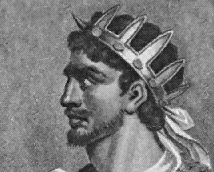
Attila the Hun

One of the most feared and notorious barbarians of all time, Attila, was not a Germanic or Celtic barbarian, but Hunnish. Believed to be of distant Mongol stock, he ravaged much of the European continent during the 5th century C.E. Apparently Attila was as great a menace to the Teutonic tribespeople as he was to the Romans; he and his forces were finally defeated by both Germans and Romans working together (!) in 451 C.E. Attila supposedly died soon after. The rumors of his cannibalistic practices are not unfounded; he is supposed to have eaten two of his sons, even. He actually does make a cameo appearance in the Volsung saga, as Gutrune’s second husband after Sigurd’s death.

Boadicea (Boudicca)
Not all of the famous barbarians were male. The warrior queen of the Celts, Boadicea, who reigned the tuath Iceni in what is now England during the 1st century C.E., was one such female barbarian. In 61 C.E., she led a revolt against the Roman invaion of Britain in retaliation for the rape of her daughters by the Roman soldiers (under order from their superiors.) Her army of Celts was victorious at first and pushed the Romans back to London, which Boadicea and her forces sacked and burned to the ground, killing almost all of the Roman citizens therein. Her luck held until the battle of Mancetter, where she and her army was defeated by the Roman general Suetonius Paulinus. She allegedly died by taking poison administered by one of her faithful druids, rather than suffer the ignominy of capture by her hated enemies.

Carolus Magnus (Charlemagne)
The grandson of Charles Martel (see below), Charles I of France (April 2, 742-814 C.E.), the last of the Frankish Barbarian kings, conquered much of Continental Europe, including the areas of France, Germany, Poland, Austria, Hungary, some of the Balkan states, and parts of Italy.
He was crowned Holy Roman Emperor in 800 C.E. by Pope Leo III, and was supposedly surprised at the Coronation; Pope Leo having devised it on the sly. He never learned to read or write, although was very learned by listening to visiting scholars and monks read to him from the ancient works.
Although the Carolingian dynasty lasted only one generation after Charlemagne, the Empire lasted 1,118 years until the year 1918 C.E., when the last Holy Roman (Hapsburg) Emperor, Karl, was defeated at the end of World War I. Among other cultural reforms, Charlemagne was the first to establish the idea of the Divine Right of succession, in which the King was considered to be an avatar of the Christian God, as was his heir apparent.
Most of the constitutional traditions of continental European kingdoms were derived from the reign of Charlemagne.

Charles Martel
A Frankish barbarian of the eastern Frankish kingdom of Austrasia, Charles Martel (688 – 741 C.E.) was most famous for the Battle of Tours (732 C.E.), near Poitiers, in which he successfully defeated the Saracen Moors in their invasion of France, thus preserving Christian Europe from the encroachment of Islam. He held the title of Mayor of the Palace of Austrasia, but in actuality wielded the power of a king. His byname, “Martel,” meant “hammer” and was used to describe the way he indefatigably drove back the Moorish invasion.

Genseric (Gaiseric)
The Vandal king, Genseric, or Gaiseric as he was also known, was one of the more notorious Barbarians, and is probably largely the cause of the word “Vandal” becoming a derogatory term in modern language. He was harsh and cruel, both toward his subjects and towards the Romans, and was a rabid Christian of a radical sect, violently opposed to any other expression of Christianity or Paganism.
Allegedly born on December 11, 390 C.E. in Gaul, Genseric was proclaimed king of the Vandals in 428, deposing (and disposing of) his brother.
In 439, he and his troops seized the Roman city of Carthage on the North African coast, and established a barbarian stronghold there, becoming an independent ruler of North Africa in 442.
He established treaties with the Romans, which he later breached, and in 455, succeeded in sacking and looting Rome itself.
From 455 to his death (of old age!) in 477, the Vandals, under Genseric’s leadership, were the rulers of the Mediterranean sea; providing one of the first examples of Barbarian maritime warpower.
Many of Genseric’s people remained in southern Spain as well, along with the Visigoths (who actually ran many of the Vandals out of Hispania and into North Africa). The region was known as “Vandalus” until the invasion of the Islamic Moors in 711 C.E., when they overran the region and renamed it “Al-Andalus.” Today, the Spanish region “Andalusia” bears the name and ancient culture derived from both of these civilizations.

Gundahar (Gunthur)
The Burgundian king Gundahar actually existed, although his legendary account is more famous, thanks to Wagner. He reigned in the court of Worms in what is now southwestern Germany, along the Rhine. In the legends of the Volsung saga and the Nibelungenleid, he is the brother of Gudrun, wife of Sigurd (Sigifried) the Dragon-slayer; and husband of Brunhildde. Because of the treachery in which he and his half-brother Hagan slayed Sigurd, he was doomed to defeat at the hands of Attila in 436. Whether or not the legend is fully true, King Gundahar did die at the hands of Attila and his forces, along with 20,000 of his Burgundian warriors. His descendents became part of the French nation; Bourgogne is one of the main divisions of France to this day.

Hermann/Arminius
A drighten of the Cherusci, Hermann served under General Varus during the Roman campaign to conquer Germany.